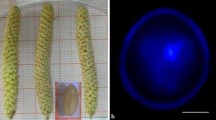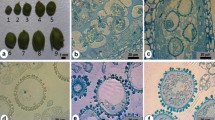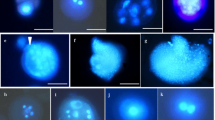Abstract
Microspore culture is a very important and useful tool in plant breeding for haploid production and has been developed for many years.Brassica campestris (Brassica rapa L. ssp.oleifera) is an important oilseed crop, but it is relatively recalcitrant in tissue culture including microspore culture. The microspore culture in our laboratory is based on the Canadian protocol. Thirty genotypes ofB. campestris were included in this study; twenty produced embryos. The highest yield was 5930 embryos per 100 buds from Canadian genotype Cv-2, this result was one of the best that had been reported in microspore culture inB. campestris. The buds measuring 2.0 mm to 3.9 mm in length responded best to produce embryos, the optimum timing for microspore culture was confirmed to be during the mid-late to very-late uninucleate stage. The buds could be removed from either the main raceme or lateral racemes. Activated charcoal (150 mg l-1) was added to the liquid NLN medium, it promoted embryogenesis significantly; embryo development was faster and the embryo yield was significantly higher than those cultures without activated charcoal. The donor plant condition was considered an important factor influencing embryogenesis; older donor plants (older than five weeks) and a cold treatment are recommended.
Similar content being viewed by others
Abbreviations
- BA:
-
6-benzylaminopurine
- DAPI:
-
4′, 6′-diamidino-2-phenylindol
- IAA:
-
indole-3-acetic acid
- NAA:
-
α-naphthaleneacetic acid
References
BaillieAMR, EppDJ, HutchesonD & KellerWA (1992)In vitro culture of isolated and regeneration of plants inBrassica campestris. Plant Cell Rep. 11: 234–237
BurnettL, YarrowS & HuangB (1992) Embryogenesis and plant regeneration from isolated microspores ofBrassica rapa L. spp.oleifera. Plant Cell Rep. 11: 215–217
ChuongPV, DeslauriersC, KottLS & BeversdorfWD (1988) Effects of donor genotype and bud sampling on microspore culture ofBrassica napus. Can. J. Bot. 66: 1653–1657
DumasE & MonteuuisO (1995)In vitro rooting of micropagated shoots from juvenile and maturePinus pinaster explants: influence of activated charcoal. Plant Cell Tiss. Org. Cult. 40: 231–235
Dunwell JM (1985) Haploid cell culture. In: Dixon RA (ed). Plant Cell Culture. Oxford, Washington DC (p 21)
FerrieAMR, EppDJ & KellerWA (1995a) Evaluation ofBrassica rapa L. genotypes for microspore culture response and identification of a highly embryogenic line. Plant Cell Rep. 14: 580–584
Ferrie AMR & Keller WA (1995b) Development of methodology and applications of doubled haploids inBrassica rapa. Proceedings of the 9th International Rapeseed Congress, G35. Cambridge, UK. 1995
FridborgG, PedersenM, LandströmL & ErikssonT (1978) The effect of activated charcoal on tissue culture: Adsorption of metabolites inhibiting morphogenesis. Physiol. Plant 43: 104–106
GamborgOL, MillerRA & OjimaK (1968) Nutrient requirements of suspension cultures of soybean root cells. Exp. Cell Res. 50: 151–158
Guo YD & Pulli S (1995) Preliminary report on embryogenesis ofBrassica rapa L. ssp.oleifera viain vitro isolated microspore culture. 14th EUCARPIA Congress Abstract Book (p. 97)
HansenM & SvinnsetK (1993) Microspore culture of Swede (Brassica napus spp.rapifera) and the effects of fresh and conditioned media. Plant Cell Rep. 12: 496–500
KottLS & BeversdorfWD (1990) Enhanced plant regeneration from microspore-derived embryos ofBrassica napus by chilling, partial desiccation and age selection. Plant Cell Tiss. Org. Cult. 23: 187–192
KottLS, PolsoniL & BeversdorfWD (1988) Cytological aspects of isolated microspore culture ofBrassica napus. Can. J. Bot. 66: 1658–1664
LichterR (1982) Induction of haploid plants from isolated pollen ofBrassica napus. Z. Pflanzenphysiol. 105: 427–434
LushW & FriedtW (1994) The major oil crops. In: MurphyDJ (ed) Designer Oil Crops. VCH Verlagsgesellschaft mbH, D-69451 Wemheim (p.27)
NitschJP (1972) Haploid plants from pollen. Z. Pflanzenzüchtg 67: 3–18
OsolnikB, BohanecB & JelaskaS (1993) Stimulation of androgenesis in white cabbage (Brassica oleracea var.capitata) anthers by low temperature and anther dissection. Plant Cell Tiss. Org. Cult. 32: 241–246
PierikRLM (1987)In Vitro Culture of Higher Plants. Martinus Nijhoff Publishers, Dordrecht
SiebelJ & PaulsKP (1989) A comparison of anther and microspore culture as a breeding tool inBrassica napus. Theor. Appl. Genet. 78: 473–479
SorvariS (1985) Production of haploids from anther culture in agriculturally valuableBrassica campestris L. cultivars. Ann. Agr. Fenn. 24: 149–160
SwansonEB, CoumansMP, WuSC, BarsbyTL & BeversdorfWD (1987) Efficient isolation of microspores and the production of microspore-derived embryos fromBrassica napus. Plant Cell Rep. 6: 94–97
TakahataY, BrownDCW & KellerWA (1991) Effect of donor plant age and inflorescence age on microspore culture ofBrassica napus L.. Euphytica 58: 51–55
WangCC, SunCS & ChuZC (1974) On the conditions for the induction of rice pollen plantlets and certain factors affecting the frequency of induction. Acta Botanica Sinica 16: 43–53
ZhaoKN, WhitecrossMI & BittisnichDJ (1994) Study on plant regeneration from cotyledonary protoplasts inBrassica campestris. Plant Cell Rep. 13: 164–170
Author information
Authors and Affiliations
Rights and permissions
About this article
Cite this article
Guo, YD., Pulli, S. High-frequency embryogenesis inBrassica campestris microspore culture. Plant Cell Tiss Organ Cult 46, 219–225 (1996). https://doi.org/10.1007/BF02307098
Received:
Accepted:
Issue Date:
DOI: https://doi.org/10.1007/BF02307098




